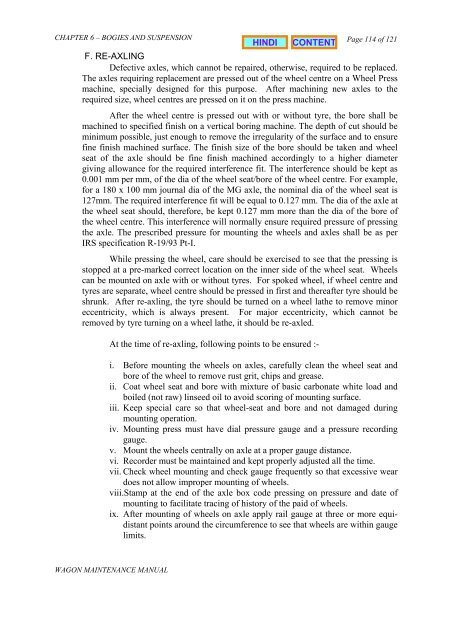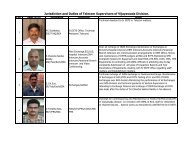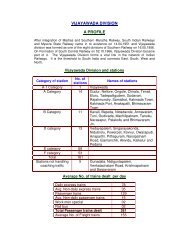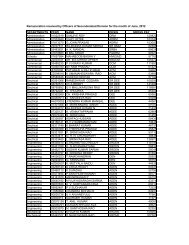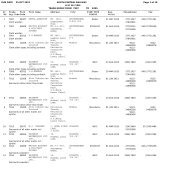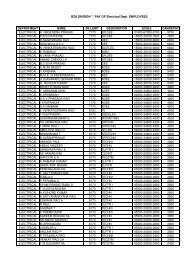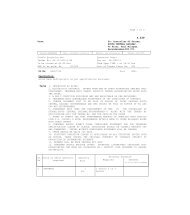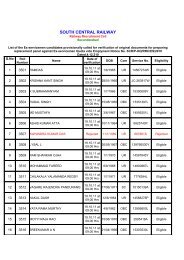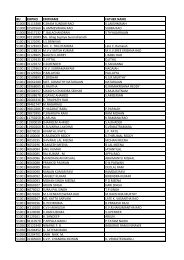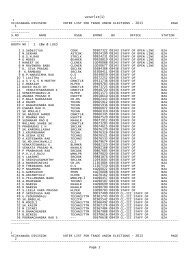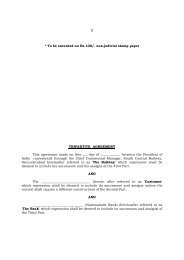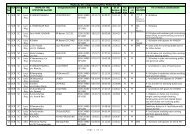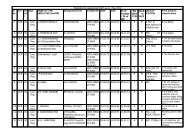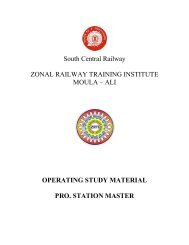BOGIES AND SUSPENSION - South Central Railway
BOGIES AND SUSPENSION - South Central Railway
BOGIES AND SUSPENSION - South Central Railway
Create successful ePaper yourself
Turn your PDF publications into a flip-book with our unique Google optimized e-Paper software.
CHAPTER 6 – <strong>BOGIES</strong> <strong>AND</strong> <strong>SUSPENSION</strong><br />
WAGON MAINTENANCE MANUAL<br />
Page 114 of 121<br />
Defective axles, which cannot be repaired, otherwise, required to be replaced.<br />
The axles requiring replacement are pressed out of the wheel centre on a Wheel Press<br />
machine, specially designed for this purpose. After machining new axles to the<br />
required size, wheel centres are pressed on it on the press machine.<br />
After the wheel centre is pressed out with or without tyre, the bore shall be<br />
machined to specified finish on a vertical boring machine. The depth of cut should be<br />
minimum possible, just enough to remove the irregularity of the surface and to ensure<br />
fine finish machined surface. The finish size of the bore should be taken and wheel<br />
seat of the axle should be fine finish machined accordingly to a higher diameter<br />
giving allowance for the required interference fit. The interference should be kept as<br />
0.001 mm per mm, of the dia of the wheel seat/bore of the wheel centre. For example,<br />
for a 180 x 100 mm journal dia of the MG axle, the nominal dia of the wheel seat is<br />
127mm. The required interference fit will be equal to 0.127 mm. The dia of the axle at<br />
the wheel seat should, therefore, be kept 0.127 mm more than the dia of the bore of<br />
the wheel centre. This interference will normally ensure required pressure of pressing<br />
the axle. The prescribed pressure for mounting the wheels and axles shall be as per<br />
IRS specification R-19/93 Pt-I.<br />
While pressing the wheel, care should be exercised to see that the pressing is<br />
stopped at a pre-marked correct location on the inner side of the wheel seat. Wheels<br />
can be mounted on axle with or without tyres. For spoked wheel, if wheel centre and<br />
tyres are separate, wheel centre should be pressed in first and thereafter tyre should be<br />
shrunk. After re-axling, the tyre should be turned on a wheel lathe to remove minor<br />
eccentricity, which is always present. For major eccentricity, which cannot be<br />
removed by tyre turning on a wheel lathe, it should be re-axled.<br />
At the time of re-axling, following points to be ensured :-<br />
i. Before mounting the wheels on axles, carefully clean the wheel seat and<br />
bore of the wheel to remove rust grit, chips and grease.<br />
ii. Coat wheel seat and bore with mixture of basic carbonate white load and<br />
boiled (not raw) linseed oil to avoid scoring of mounting surface.<br />
iii. Keep special care so that wheel-seat and bore and not damaged during<br />
mounting operation.<br />
iv. Mounting press must have dial pressure gauge and a pressure recording<br />
gauge.<br />
v. Mount the wheels centrally on axle at a proper gauge distance.<br />
vi. Recorder must be maintained and kept properly adjusted all the time.<br />
vii. Check wheel mounting and check gauge frequently so that excessive wear<br />
does not allow improper mounting of wheels.<br />
viii. Stamp at the end of the axle box code pressing on pressure and date of<br />
mounting to facilitate tracing of history of the paid of wheels.<br />
ix. After mounting of wheels on axle apply rail gauge at three or more equidistant<br />
points around the circumference to see that wheels are within gauge<br />
limits.


